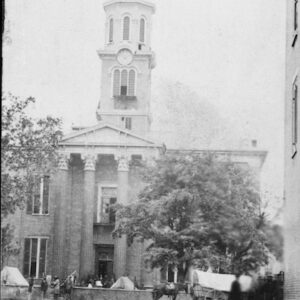Tag: Murfreesboro TN
Wikipedia says: Murfreesboro is a city in and county seat of Rutherford County, Tennessee, United States. Serving as the state capital from 1818 to 1826, it was superseded by Nashville.
History
On October 27, 1811, the Tennessee General Assembly designated the location for a new county seat for Rutherford County, giving it the name Cannonsburgh in honor of Newton Cannon, representative to the Assembly for the local area. At the suggestion of William Lytle, it was renamed Murfreesborough on November 29, 1811, after Revolutionary War hero Colonel Hardy Murfree. The name was shortened to Murfreesboro in January 1812 when the town was formally chartered. Author Mary Noailles Murfree was his great-granddaughter.
As Tennessee settlement expanded to the west, the location of the state capital in Knoxville became inconvenient for much of the population. In 1818, Murfreesboro was designated as the capital of Tennessee and its population boomed. Eight years later, however, it was superseded by Nashville.
Civil War
On December 31, 1862, the Battle of Stones River, also called the Battle of Murfreesboro, was fought near the city between the Union Army of the Cumberland and the Confederate Army of Tennessee. This was a major engagement of the American Civil War, and between December 31 and January 2, 1863, the rival armies suffered a combined total of 23,515 casualties. It was the bloodiest battle of the war by percentage of casualties.
Following the Confederate retreat after the drawn Battle of Perryville in central Kentucky, the Confederate army moved through East Tennessee and turned northwest to defend Murfreesboro. General Braxton Bragg’s veteran cavalry successfully harassed Union General William Rosecrans’ troop movements, capturing and destroying many of his supply trains. However, they could not completely prevent supplies and reinforcements from reaching Rosecrans. Despite the large number of casualties, the battle was inconclusive. It is usually considered a Union victory, since afterward General Bragg retreated 36 miles (58 km) south to Tullahoma. Even so, the Union army did not move against Bragg until six months later, in June 1863. The battle was significant since the Union gained a base from which it could push its eventual drive further south, which enabled its later advances against Chattanooga and Atlanta. The Union eventually divided the territory into the Eastern and Western theaters, followed by Sherman’s March to the Sea through the South. The Stones River National Battlefield is now a national historical site.
General Rosecrans’ move to the south depended on a secure source of provisions, and Murfreesboro was chosen for his supply depot. Soon after the battle, Brigadier General James St. Clair Morton, Chief Engineer of the Army of the Cumberland, was ordered to build Fortress Rosecrans, some 2 miles (3.2 km) northwest of the town. The fortifications covered about 225 acres (0.91 km2) and were the largest built during the war. Fortress Rosecrans consisted of eight lunettes, four redoubts, and connecting fortifications. The fortress was built around the Nashville and Chattanooga Railroad and the West Fork of the Stones River; two roads provided additional access and transportation.
The fort’s interior was a huge logistical resource center, including sawmills, warehouses, quartermaster maintenance depots, ammunition magazines, and living quarters for the 2,000 men who handled the operations and defended the post. After the fortress was completed in June 1863, Rosecrans ventured to the south. The fortress was never attacked, in part because the Union troops held the town of Murfreesboro hostage by training their artillery on the courthouse. Major portions of the earthworks still exist and have been incorporated into the battlefield historic site.
Showing all 11 resultsSorted by latest










